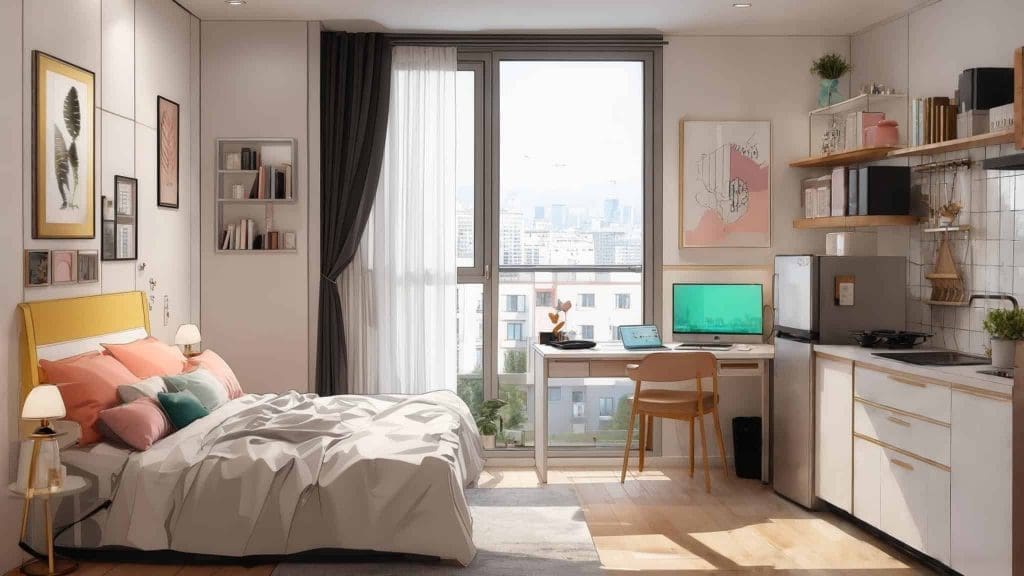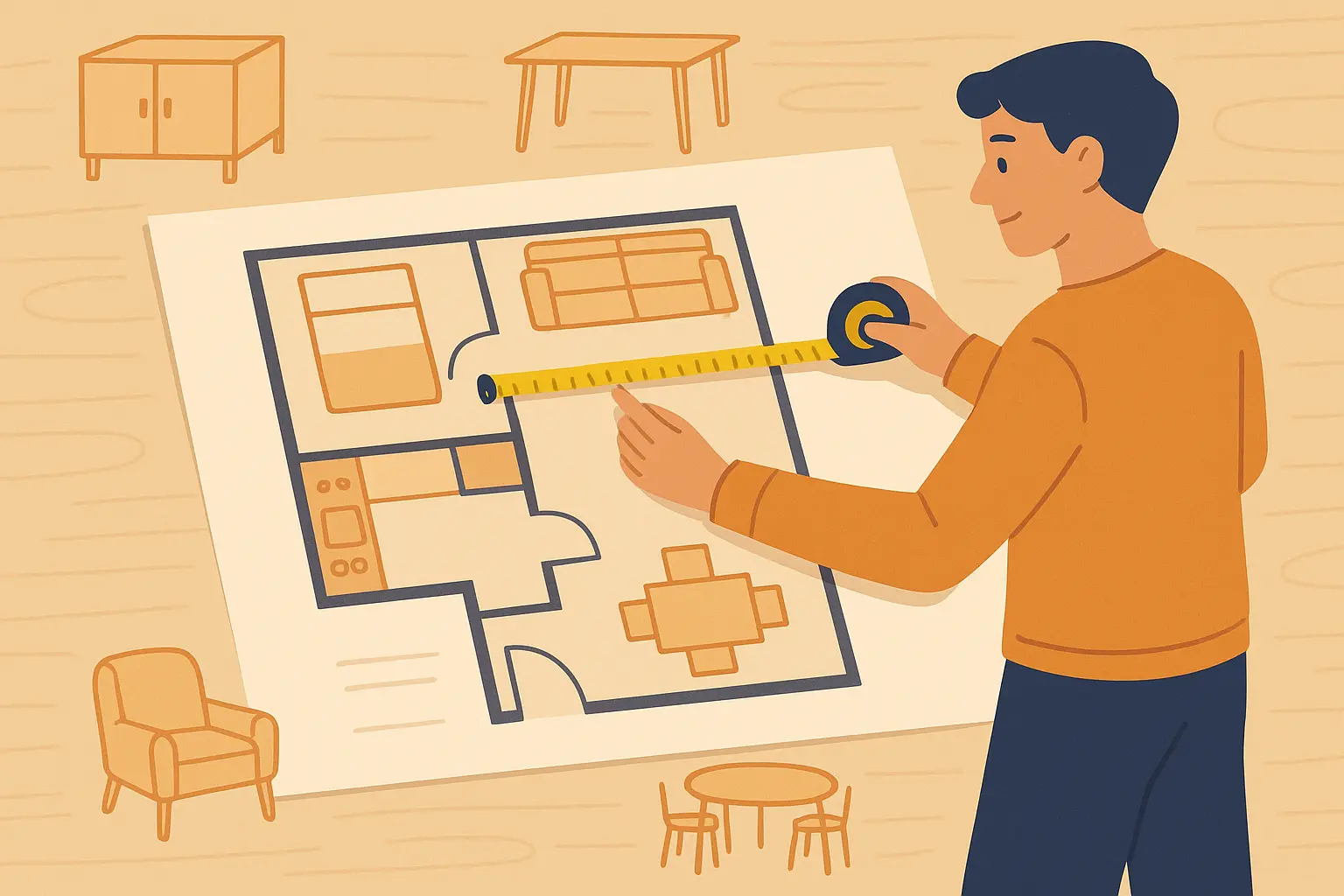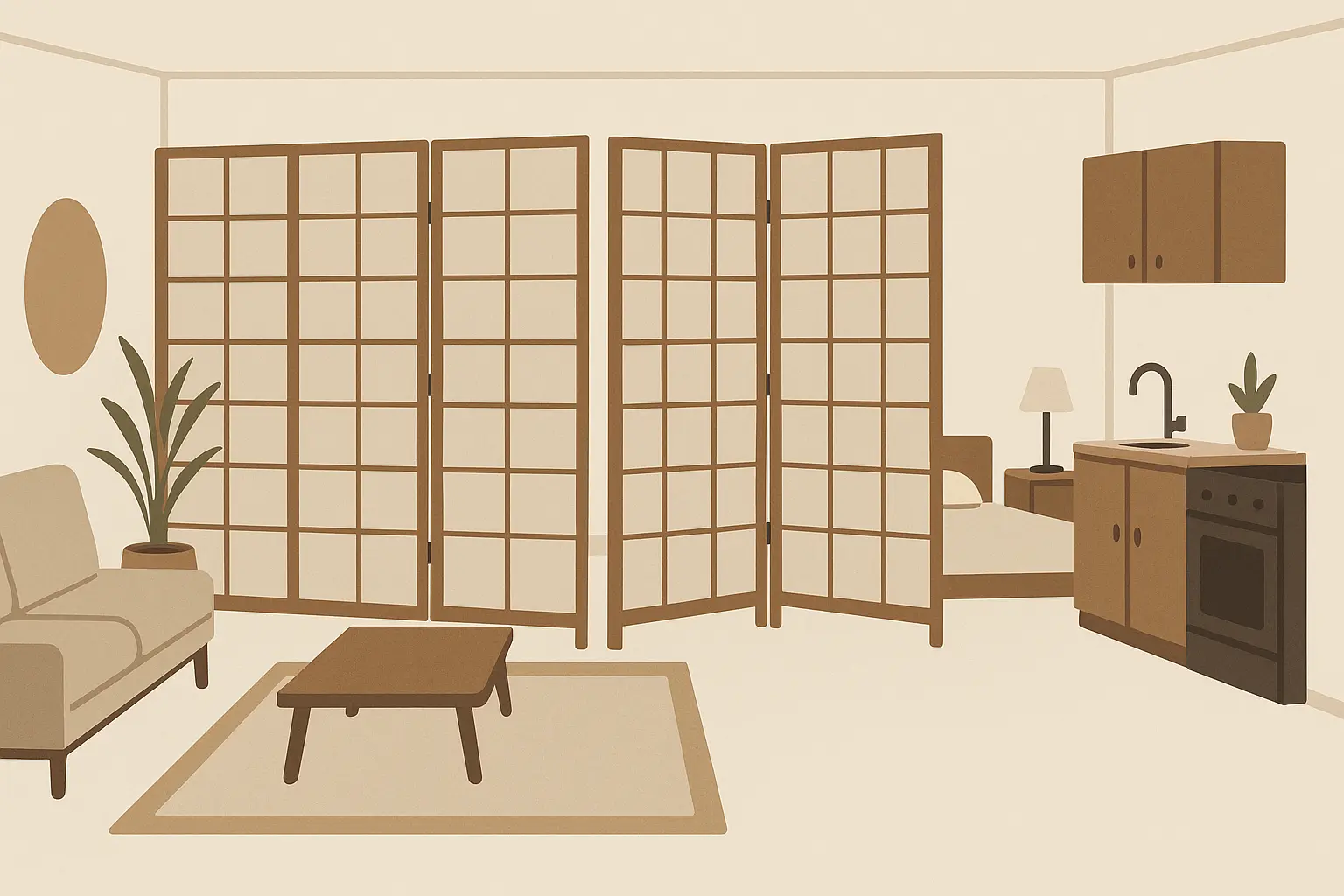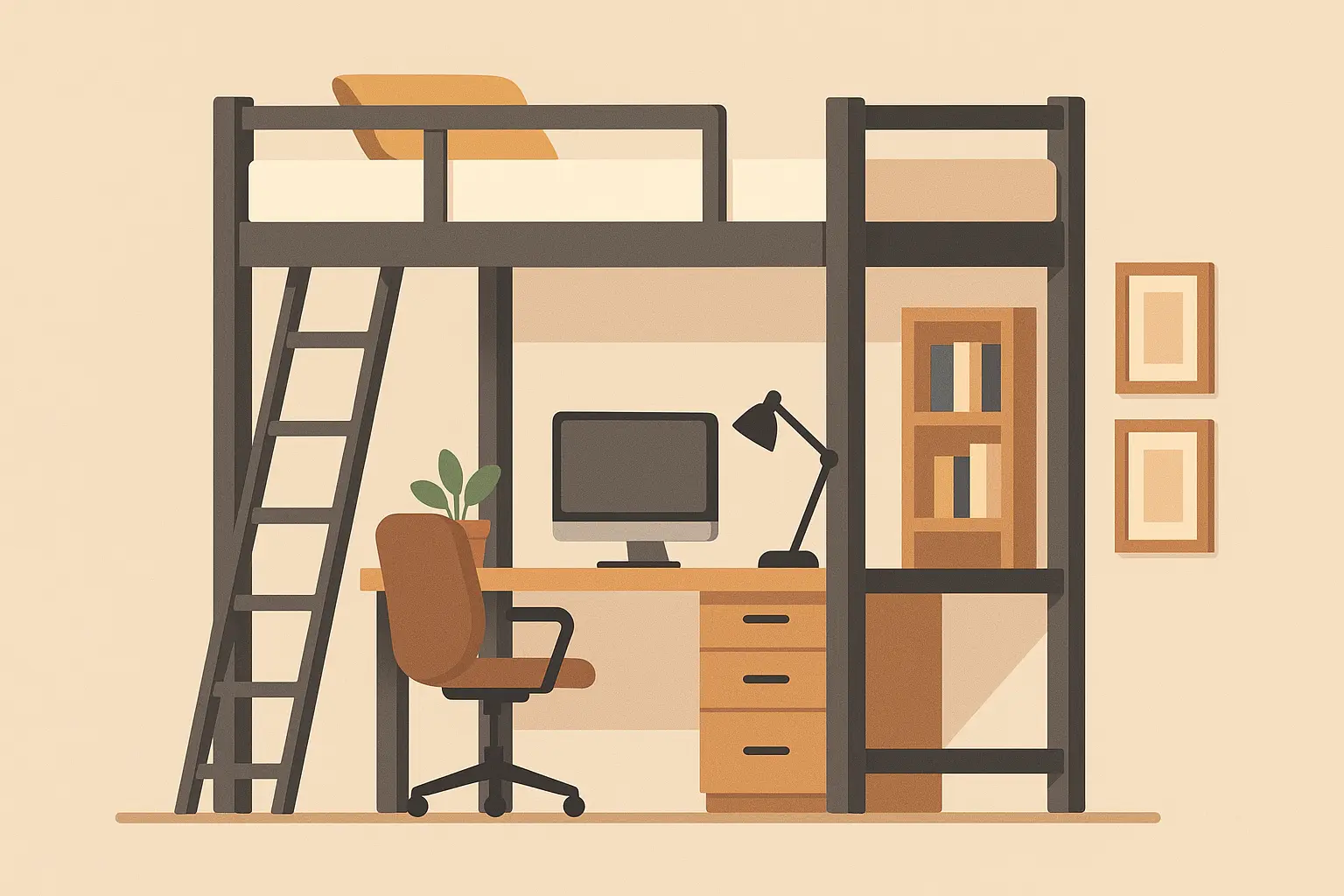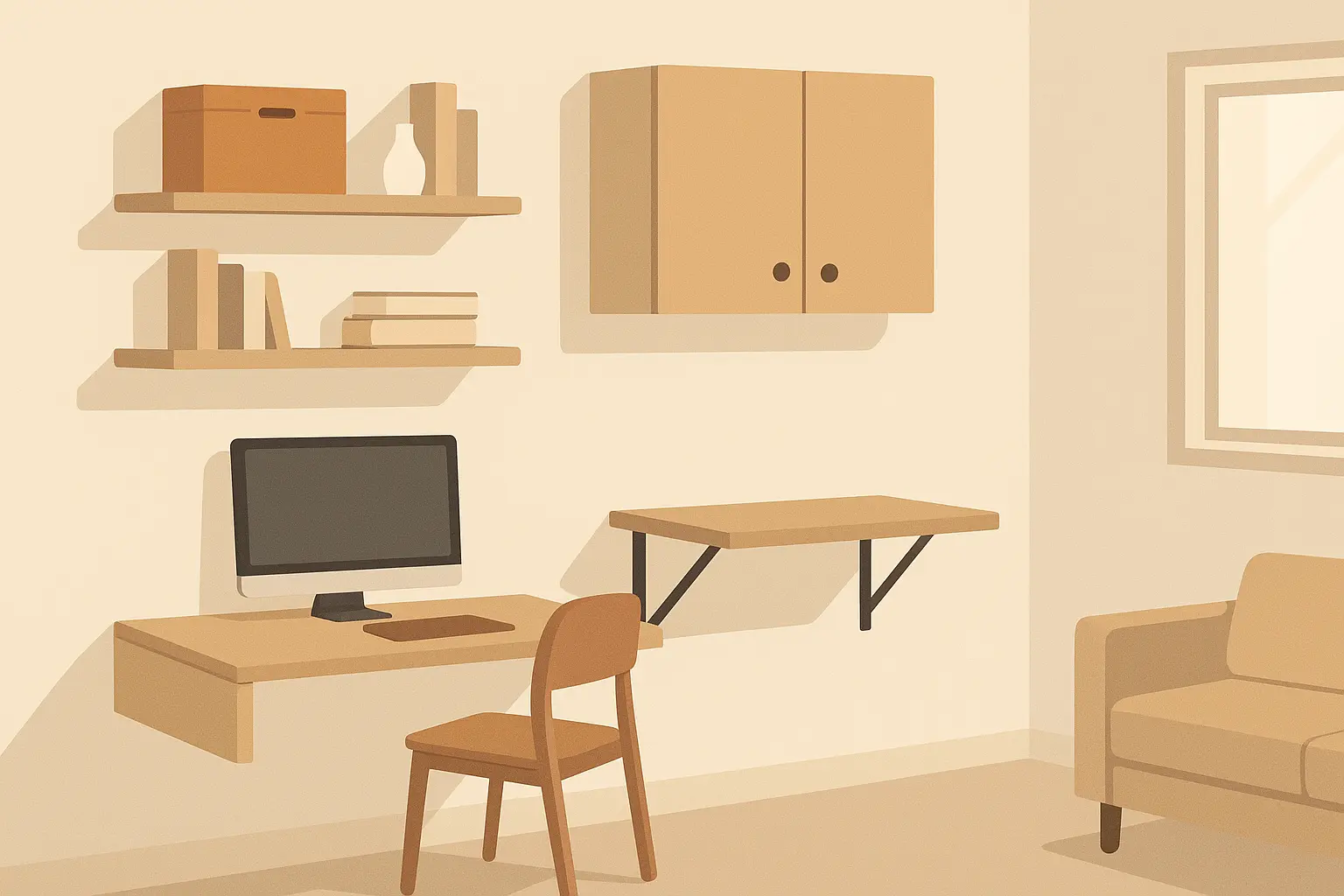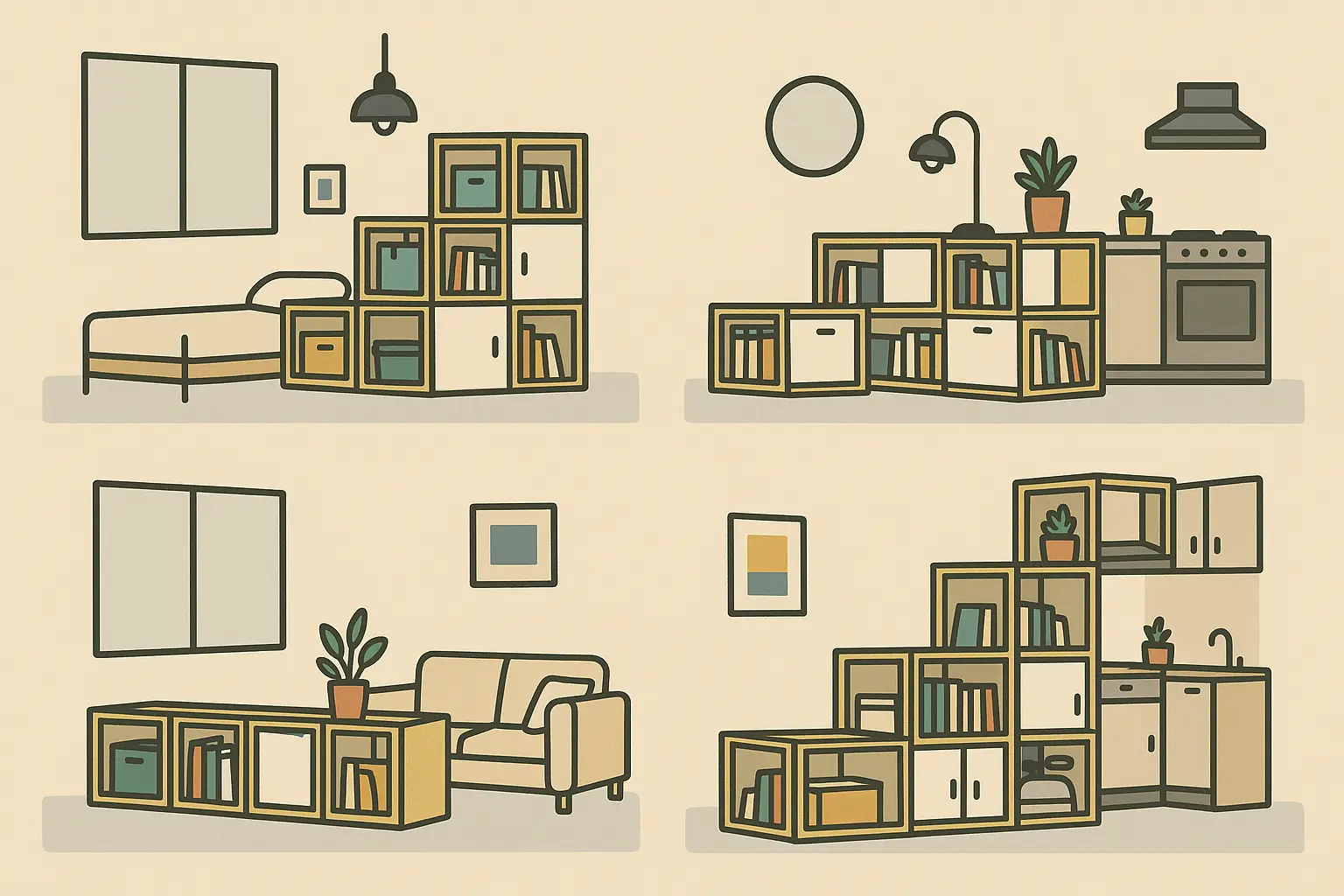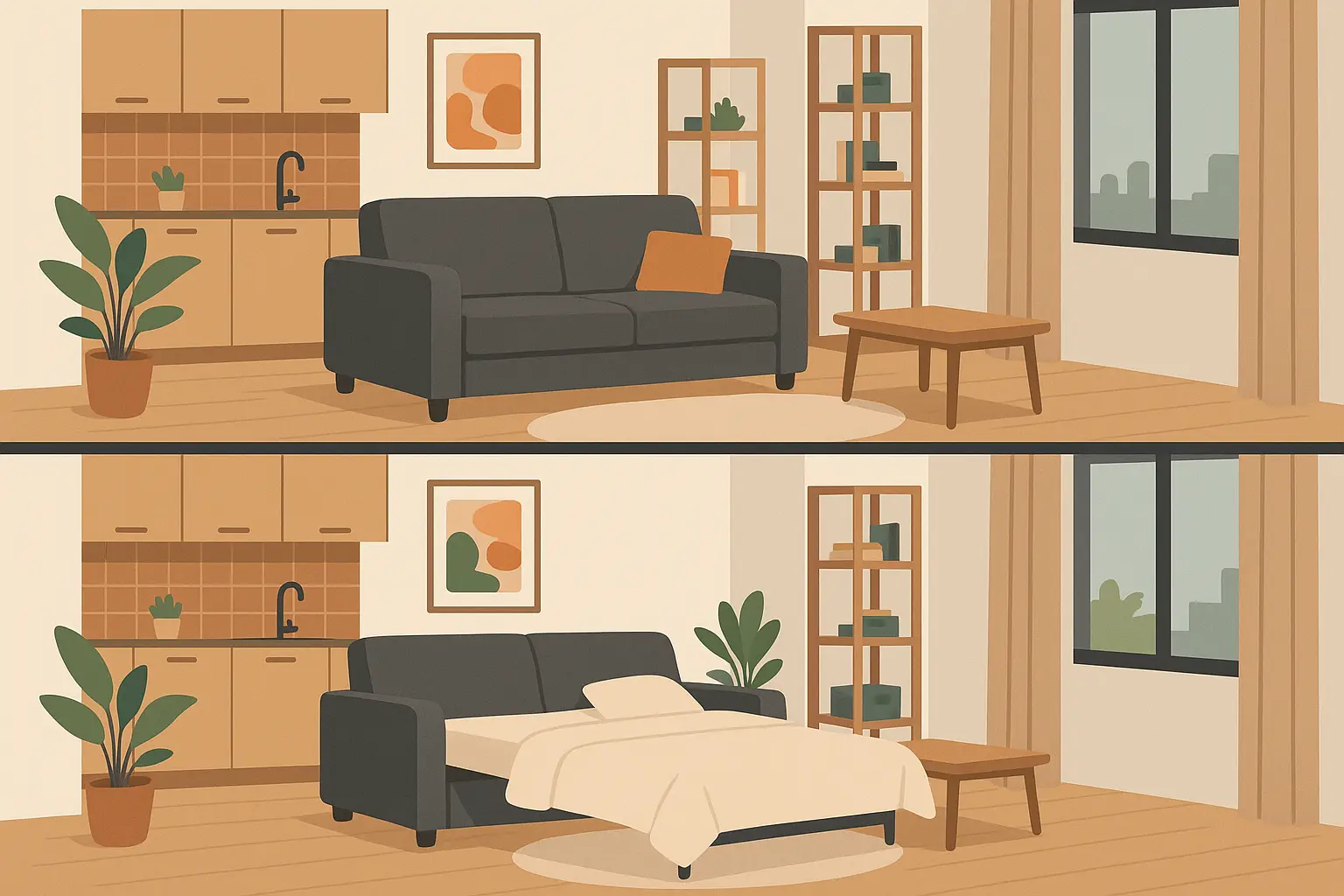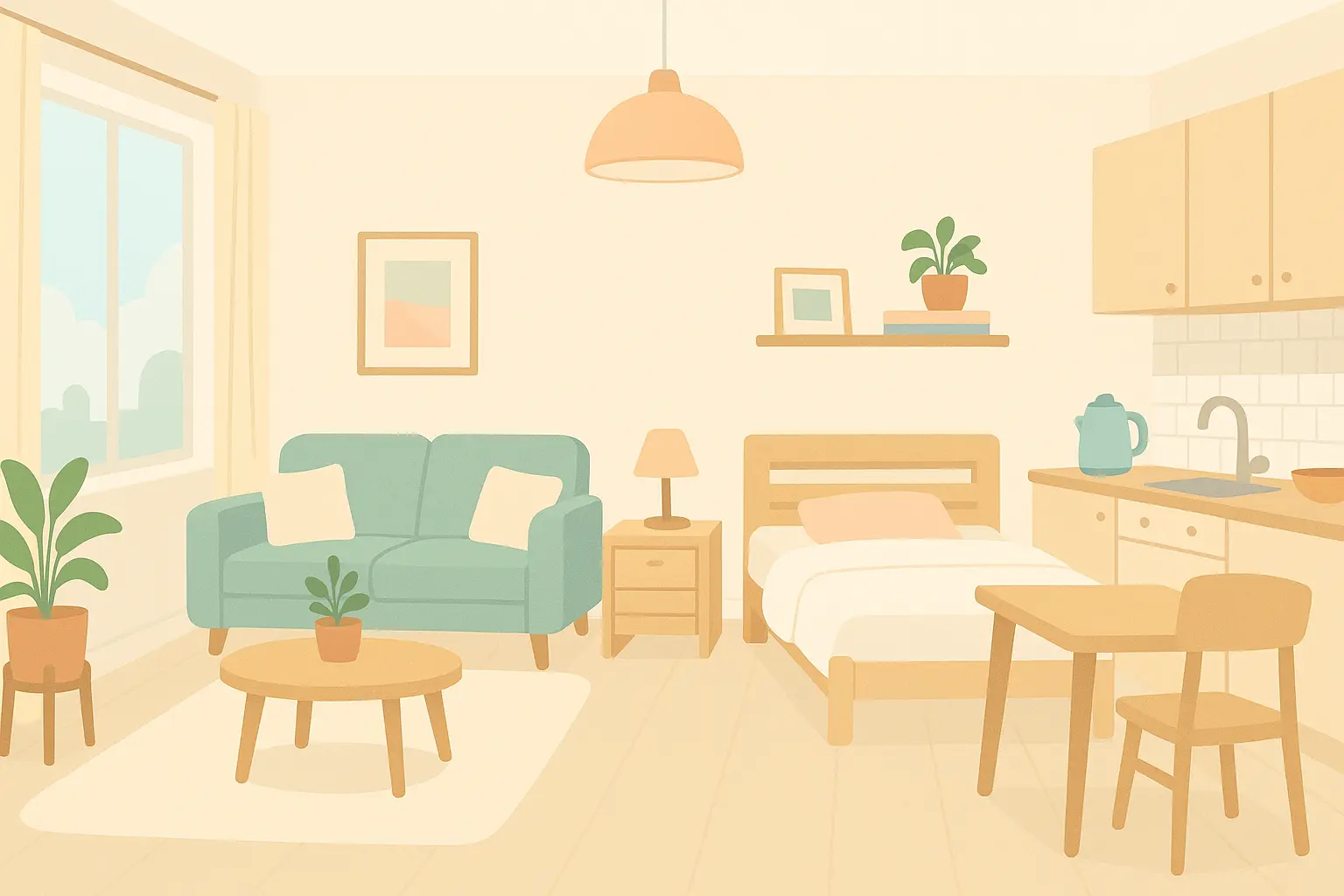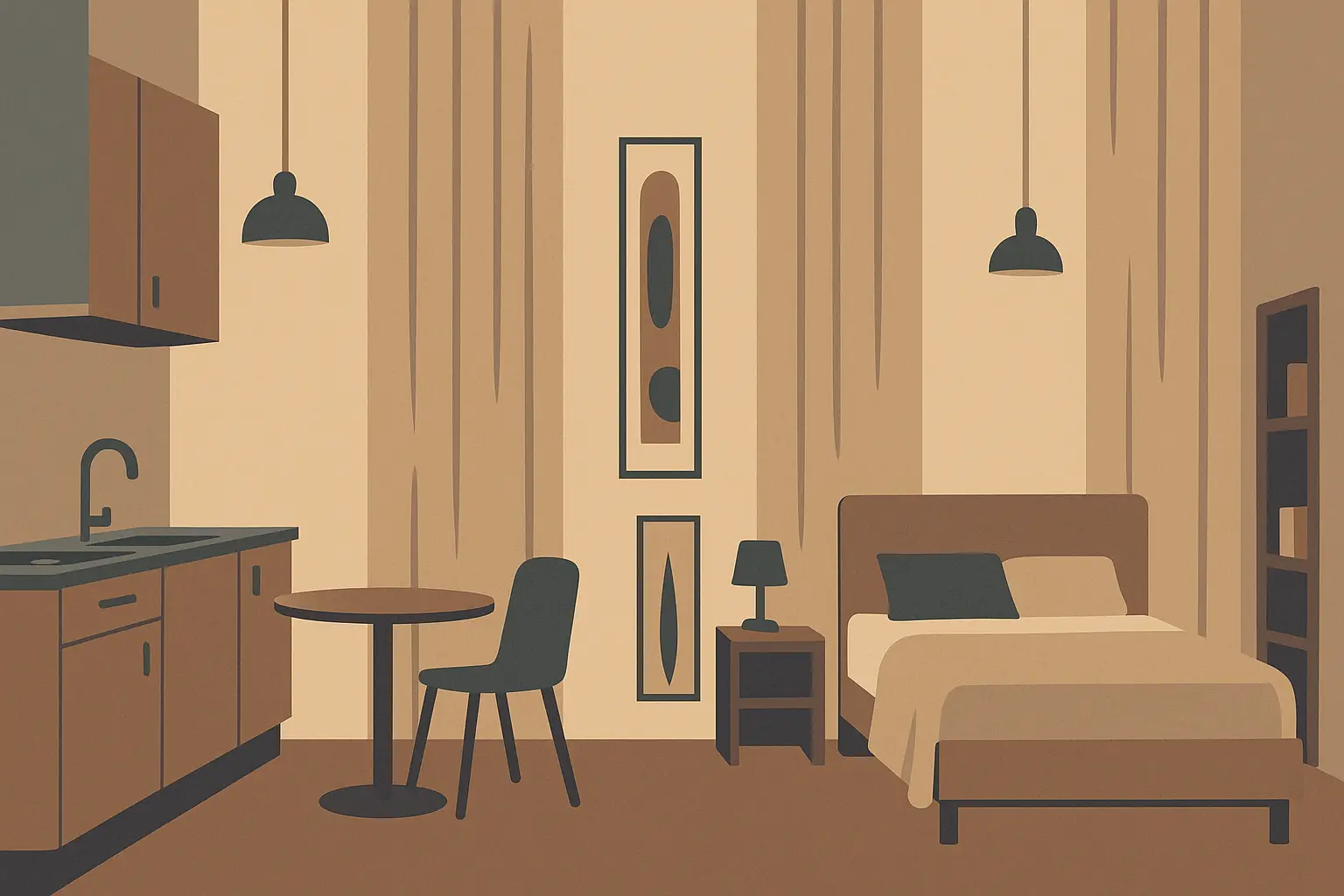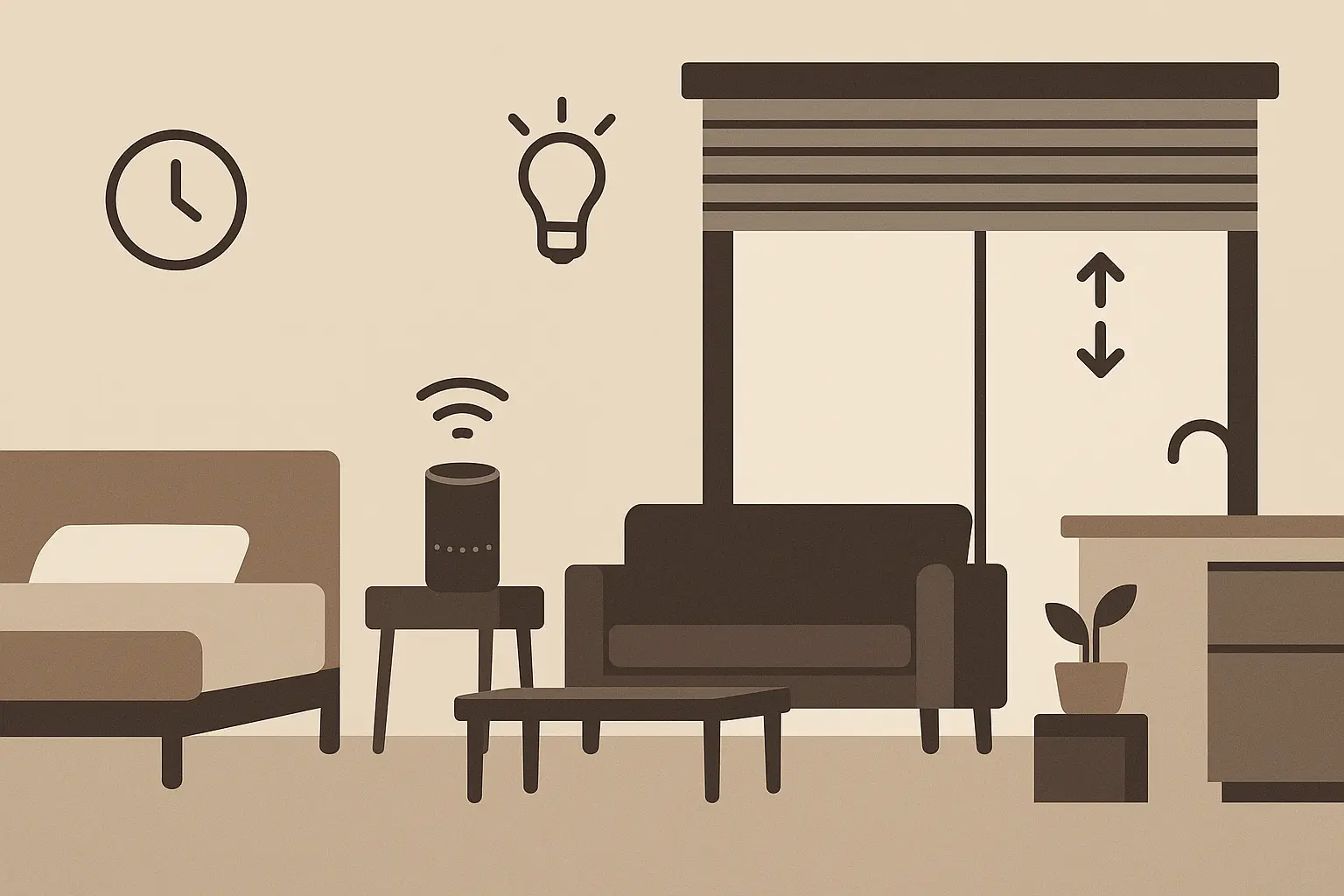25 Studio Apartment Ideas That’ll Transform Your Tiny Space Into a Dream Home
Look, I’ll be honest – when I first moved into my shoebox studio, I definitely had a mini panic attack. I remember staring at my first 300-square-foot space, wondering how I’d fit my entire life into what felt like an oversized closet. But here’s what I learned: that overwhelming feeling quickly transformed into excitement when I discovered how strategic design choices could make my tiny space feel surprisingly spacious and incredibly functional.
According to House Beautiful, creative floor plan solutions and multifunctional furnishings can help you utilize studio apartment ideas that work with your lifestyle, even in the tightest spaces.
Living in a studio doesn’t mean sacrificing comfort or style—it means getting creative with every square inch you have. And let’s be real about money here – not everyone can drop $1,500 on fancy transforming furniture. Whether you’re a first-time renter working with a shoestring budget or looking to refresh your current space without breaking the bank, these 25 studio apartment ideas will help you create a home that works as hard as you do.
Table of Contents
-
Key Planning Considerations for Studio Success
-
Space Division and Layout Solutions
-
1. Room Divider Screens and Curtains
-
2. Platform Bed with Integrated Storage
-
3. Loft Bed Configurations
-
4. Open Shelving as Dividers
-
5. Multi-Level Flooring
-
6. Sliding Panel Systems
-
-
Smart Storage Solutions
-
7. Wall-Mounted Everything
-
8. Under-Stair Storage Solutions
-
9. Ceiling-Mounted Storage
-
10. Hidden Storage Furniture
-
11. Modular Storage Systems
-
12. Vertical Closet Maximization
-
-
Multi-Functional Furniture Ideas
-
13. Convertible Dining Solutions
-
14. Sofa Bed Combinations
-
15. Expandable Work Surfaces
-
16. Storage Seating Options
-
17. Transforming Tables
-
18. Modular Seating Systems
-
-
Design and Aesthetic Solutions
-
19. Light Color Palettes
-
20. Mirror Placement Strategies
-
21. Vertical Design Elements
-
22. Minimalist Approach
-
-
Technology and Modern Solutions
-
23. Smart Home Integration
-
24. Compact Appliance Solutions
-
25. Wireless and Cord Management
-
-
How JiffyJunk Can Help Your Studio Transformation
TL;DR
-
You don’t need walls to create separate zones—screens, curtains, and smart furniture placement work wonders
-
Look up! Vertical space is your secret weapon for storage and making your place feel bigger
-
Furniture that does double duty eliminates clutter while actually being useful (when it works)
-
Light colors and mirrors aren’t just pretty—they’re psychological tricks that make your brain think you have more space
-
Smart tech is cool when it works, frustrating when it doesn’t, but compact appliances can be total game-changers
-
Sometimes you need professional help to clear out the clutter before you can make any of this magic happen
Key Planning Considerations for Studio Success
Before you start buying furniture or rearranging everything, let’s talk about what actually matters when you’re working with limited space and (let’s be honest) probably a limited budget too.
Success in studio living starts with understanding what you’re working with and what you actually need—not what looks good on Pinterest. Every decision you make will impact multiple aspects of your daily life, so taking time to plan prevents costly mistakes and ensures your space truly works for you, not against you.
Here’s the thing about space optimization—it’s not about cramming more stuff into less space. It’s about making your space work better. You need to think about how you actually move through your day. Do you work from home and need a real desk setup? Are you someone who loves cooking elaborate meals, or do you survive on takeout and cereal? Be honest about your lifestyle because your space should support how you actually live, not how you think you should live.
|
Planning Category |
What Actually Matters |
Real-World Impact |
|---|---|---|
|
Making Your Space Work |
How you move around, where light comes from, traffic flow |
Where you put furniture, how high you store things, whether you can actually use your space |
|
What You Actually Need |
Work setup, storage for your actual stuff, how often you have people over |
What furniture to buy, how to set up work areas, how much seating you really need |
|
Money & Time Reality |
What you can afford now, what you can DIY, rental restrictions |
What to buy first, what to skip, what you can’t change |
|
Daily Life Stuff |
Can you actually clean it, will it break, is it too complicated |
What materials to choose, how accessible storage should be, keeping things simple |
Let’s talk about functional requirements for a minute. A freelance graphic designer needs different solutions than someone who’s rarely home during the day. Think about your actual daily routine—not your ideal routine, but what really happens. Do you eat breakfast standing at the counter or do you need a proper dining setup? Are you someone who has friends over constantly, or is your studio your private sanctuary? These answers matter more than any design trend.
Budget reality check time: most studio dwellers are not rolling in cash. That’s okay! Some of the best solutions are cheap or free. Cost-effectiveness becomes super important in small spaces because mistakes are visible and expensive to fix. Consider what gives you the biggest impact first—sometimes a $30 solution works better than a $300 one.
And here’s something nobody talks about enough: maintenance and practicality. When you can’t just close a door on messy areas, everything needs to stay relatively organized. Cleaning becomes crucial when you literally live in every square foot of your space. That beautiful white furniture? You’ll be cleaning it constantly. Those complex storage mechanisms? They better not break down after six months of heavy use.
Space Division and Layout Solutions
Creating separate areas within a single room requires creativity and strategic thinking. But let’s be real – you’re not trying to build the Taj Mahal here, just create some breathing room so you don’t feel like you’re eating breakfast on your pillow.
Look, I get it. When you first walk into a studio, it feels like one big box where everything happens in the same spot. You sleep where you eat, work where you watch TV, and somehow need to convince dates that yes, this is a real adult apartment.
1. Room Divider Screens and Curtains
Forget those flimsy accordion things from college. I’m talking about actual solutions that don’t make your place look like a dorm room threw up.
Room divider screens and curtains give you flexible space separation without permanent construction. You can create privacy when you need it and open everything up when you don’t. From Japanese-style folding screens to floor-to-ceiling curtains on tracks, these solutions work with various design styles while serving practical purposes.
The Curtain Track Game-Changer: Here’s what nobody tells you – ceiling-mounted curtain tracks are your best friend. Sarah (remember her from earlier?) spent $150 and one Saturday afternoon creating what feels like a completely separate bedroom. During the day, she slides everything open and boom – spacious living room. At night, she’s got privacy that actually works.
The trick is choosing the right fabric. Those sheer Instagram curtains? Pretty, but useless if you actually want privacy. Go for something substantial enough that your neighbors can’t see your silhouette doing… whatever you do in private.
Pro tip from someone who learned the hard way: Skip the beaded curtains unless you want to sound like a wind chime every time you walk through your “bedroom door.”
Floor-to-ceiling curtains on tracks offer one of the most versatile solutions available. Install tracks along the ceiling and you can create instant privacy for your sleeping area, then slide the curtains open during the day to maintain that airy, open feeling. Choose fabrics that complement your overall design while providing the right level of privacy and light filtration.
2. Platform Bed with Integrated Storage
Okay, this one’s a bigger investment, but hear me out. Remember how your childhood bunk bed had all that space underneath? Same concept, but make it adult and stylish.
Platform beds with integrated storage maximize both vertical space and under-bed storage opportunities while creating visual separation between sleeping and living areas. Options include built-in drawers, hydraulic lift mechanisms, and modular cube systems that eliminate the need for separate dressers while providing substantial storage capacity.
I lived with a platform bed for three years, and those built-in drawers saved my sanity. No more dresser eating up floor space, no more clothes explosion because everything had a home. The hydraulic lift thing sounds fancy, but honestly? Sometimes you just want to throw clean laundry somewhere without engineering a pulley system.
Reality check: You need decent ceiling height for this to work. If you’re already ducking under ceiling fans, maybe skip this one.
The raised design creates natural visual separation between your sleeping area and the rest of your studio. This psychological boundary helps maintain the feeling of having a separate bedroom even within a single room. Modular cube systems underneath can be reconfigured as your storage needs change, providing long-term flexibility.
3. Loft Bed Configurations
Adult loft beds – yes, they exist, and no, they don’t have to scream “I peaked in college.”
Loft bed configurations free up significant floor space by elevating the sleeping area, creating room underneath for home offices, reading nooks, or additional storage. These solutions require adequate ceiling height and careful consideration of access safety, but can effectively double usable floor space.
But let’s talk about the elephant in the room: climbing into bed after a long day (or a long night out) gets old fast. I had one friend who loved her loft setup until she got food poisoning and had to make that climb every time she felt queasy. Just saying.
The sweet spot: If you work from home and need a real office space, this can be a game-changer. Your “bedroom” is literally above your problems.
Murphy loft combinations take this concept further by incorporating fold-away elements that maximize flexibility. During the day, you might have a spacious office area, and at night, you can fold away work surfaces to create a more relaxing environment below your sleeping area.
4. Open Shelving as Dividers
This is where Pinterest meets reality, and sometimes reality wins.
Open shelving units serve dual purposes as room dividers and storage solutions while maintaining visual flow between areas. Industrial pipe systems, ladder-style bookcases, and geometric cube systems offer customizable configurations that provide accessible storage from both sides.
Those beautiful open shelving units look amazing when they’re perfectly styled with three books, a plant, and some artfully placed ceramics. In real life? You’ll probably stuff them with whatever needs hiding, and suddenly your room divider looks like a garage sale exploded.
Make it work: Invest in some nice storage baskets. Your random cables and that collection of takeout menus can live there without ruining the vibe.
Industrial pipe systems offer incredible customization options, allowing you to create exactly the configuration you need for your space and belongings. Ladder-style bookcases bring vertical drama while providing display space for books, plants, and decorative objects.
5. Multi-Level Flooring
This is the “I’m renovating my rental” option, which means it’s probably not happening unless you own the place or have a very chill landlord.
Multi-level flooring creates natural boundaries between functional areas through raised platforms, sunken spaces, or step-up zones. These permanent solutions work best in studios with higher ceilings and can incorporate built-in storage compartments while defining distinct areas.
But if you can swing it? Game changer. There’s something psychologically satisfying about literally stepping up into your bedroom or stepping down into your living room. It tricks your brain into thinking you have separate spaces.
Reality check: This is expensive, permanent, and your security deposit is probably not coming back.
Raised platforms work particularly well for dining areas, creating a sense of formality and separation while housing storage compartments underneath. Step-up bedroom zones provide psychological separation that helps maintain healthy sleep habits.
6. Sliding Panel Systems
Barn doors are having a moment, and honestly, they work great in studios. Just make sure you measure twice because there’s nothing worse than a sliding door that doesn’t actually slide where you need it to go.
Sliding panel systems offer adjustable privacy and space division without requiring swing clearance. Options include barn door tracks, Japanese shoji screens, and accordion-style partitions that can support various materials from lightweight fabrics to heavy wood or frosted glass.
From experience: Those Japanese shoji screens are gorgeous until you accidentally put your foot through one. Maybe save those for studios without pets, small children, or clumsy adults (so, nobody).
Barn door tracks can support heavier materials such as reclaimed wood or frosted glass, creating substantial separation that feels more traditional. Accordion-style partitions provide complete room division and work particularly well when you need to create a temporary guest room.
Smart Storage Solutions
Let’s talk about the real MVP of studio living – storage that doesn’t make your place look like a storage unit.
The truth is, you probably have way too much stuff for your space. I know, I know, you “need” all of it. But before you start building storage solutions, maybe consider if you actually need three winter coats in a 400-square-foot apartment.
Smart storage solutions maximize every available inch in studio apartments through wall-mounted furniture, ceiling storage, hidden compartments, and vertical organization systems. These approaches focus on utilizing overlooked spaces while maintaining accessibility and visual appeal.
When planning your storage solutions, consider
When planning your storage solutions, consider how professional decluttering services can help create the clean foundation needed for implementing these organizational systems effectively.
7. Wall-Mounted Everything
This is where you become one with your stud finder. If you don’t own a stud finder, get one. Your walls (and your security deposit) will thank you.
Wall-mounted furniture and appliances free up valuable floor space while creating cleaner aesthetics in studio apartments. Floating desks, wall-hung nightstands, mounted TV units, and fold-down tables provide full functionality without bulk.
Floating desks are amazing until you realize you mounted yours at the wrong height and now you’re either hunching over like Quasimodo or sitting so high your feet don’t touch the floor. Measure twice, drill once.
Mike’s reality check: Mike mounted his TV perfectly, then realized he couldn’t actually see it from his bed because he didn’t account for the angle. He lived with a crick in his neck for six months before finally remounting it. Don’t be Mike.
Wall-hung nightstands eliminate the need for floor-standing furniture beside your bed, creating easier cleaning access and a more spacious feeling. Modern designs incorporate charging stations, small drawers, and even integrated lighting.
Fold-down tables provide dining or work surfaces that completely disappear when not needed. Wall-mounted drop-leaf designs can accommodate everything from solo meals to small dinner parties, then fold flat against the wall to maximize floor space.
8. Under-Stair Storage Solutions
If you’re lucky enough to have stairs in your studio (fancy!), this space is pure gold. But custom drawers under stairs aren’t cheap, and they’re definitely not a weekend DIY project unless you’re surprisingly handy.
Under-stair storage solutions maximize otherwise wasted space in studios with stairs or raised areas through custom drawers, wine storage, shoe organizers, and small appliance storage. These solutions require custom design but offer highly efficient storage in protected locations.
Budget alternative: Plastic bins and labels. Not Instagram-worthy, but your bank account will thank you.
Custom drawer systems maximize every inch of available space under each step, creating organized storage for everything from shoes to seasonal decorations. Wine storage under stairs takes advantage of the naturally cool, dark environment while creating an attractive display feature.
9. Ceiling-Mounted Storage
This sounds great in theory until you realize you need a ladder every time you want your winter clothes. Also, everything up there will get dusty. Everything.
Ceiling-mounted storage utilizes unused vertical space for rarely accessed items through overhead bins, pulley systems, hanging pot racks, and suspended shelving. While requiring ladder access, these solutions provide excellent space optimization for seasonal items.
Learned this the hard way: That beautiful overhead bin system? Great for storing things you literally never need. Not great for anything you might want to access without planning a small expedition.
Pulley systems bring items down to accessible height when needed, then raise them back up out of the way. These work particularly well for seasonal clothing changes or items you need periodically but don’t want cluttering your daily space.
Hanging pot racks serve double duty as storage and design elements, keeping cookware accessible while freeing up cabinet space for other items. Choose designs that complement your overall aesthetic while providing practical functionality.
10. Hidden Storage Furniture
Storage ottomans are the unsung heroes of small spaces. They move around, they’re comfortable, and they hide your mess. What’s not to love?
Hidden storage furniture maximizes functionality without adding visual clutter through ottoman storage cubes, coffee tables with compartments, storage benches, and hollow base furniture. These pieces maintain their primary function while providing easily accessible storage for daily items.
Mike’s Ottoman Army: Mike bought four storage ottomans instead of a coffee table, and it changed his life. Game night? Instant seating for six. Movie night? Coffee table. Cleaning day? Everything disappears into the ottomans. This man is living in 2024 while the rest of us are stuck in 2020.
Coffee tables with lift tops or hidden compartments keep frequently used items within easy reach while maintaining clean surface areas. Look for designs with soft-close mechanisms and adequate storage depth for your specific needs.
Storage benches work particularly well in entryways or at the foot of beds, providing seating while storing shoes, bags, or seasonal items. Choose designs with cushioned tops for comfort and consider weather-resistant materials if placing near entrances.
11. Modular Storage Systems
Those cube systems from IKEA? They’re popular for a reason. You can start small, add pieces when you have money, and reconfigure when your life changes.
Modular storage systems adapt to changing needs through stackable cubes, expandable closet systems, adjustable shelving units, and mix-and-match components. These flexible solutions customize to exact space requirements while allowing for future expansion or reconfiguration.
Pro tip: Buy extra connectors. You’ll lose them, and then you’ll be that person searching through couch cushions for tiny plastic pieces.
Stackable cubes can be reconfigured seasonally—higher stacks for winter storage, spread out configurations for summer accessibility. Expandable closet systems start with basic configurations and add components as your wardrobe grows or changes.
12. Vertical Closet Maximization
Your closet has more potential than you think, but you’re probably using it wrong.
Vertical closet maximization dramatically increases storage capacity in existing closets through double-hang systems, shelf dividers, door organizers, and vacuum storage bags. These solutions improve organization and accessibility while making the most of limited closet space.
Double-hang systems are brilliant until you realize all your long dresses now live in a wrinkled pile on the floor. Measure your clothes, people.
Vacuum storage bags: They work, but opening one is like releasing a clothing explosion. Have a plan for where all that stuff is going to go when you need it.
|
Storage Solution |
Space Saved |
Best For |
Cost Range |
|---|---|---|---|
|
Double-hang systems |
40-50% more hanging space |
Short garments, shirts, pants |
$25-$75 |
|
Vacuum storage bags |
75% volume reduction |
Seasonal bedding, winter clothes |
$15-$40 |
|
Door organizers |
20+ pairs shoes or accessories |
Shoes, accessories, cleaning supplies |
$20-$60 |
|
Shelf dividers |
30% better organization |
Folded clothes, linens, towels |
$10-$30 |
Door organizers utilize the often-forgotten space on the inside of closet doors for shoes, accessories, cleaning supplies, or small items that tend to get lost in larger storage areas.
Multi-Functional Furniture Ideas
This is where you either become a space-saving genius or end up with furniture that’s mediocre at everything it tries to do.
Multi-functional furniture eliminates the need for separate pieces while maximizing utility in studio apartments. The key lies in choosing quality mechanisms and designs that enhance rather than complicate your daily routines.
13. Convertible Dining Solutions
Drop-leaf tables are great until you realize you never actually drop the leaves because it’s too much work for your Tuesday night ramen dinner.
Convertible dining solutions provide flexible eating spaces that adapt to different needs and group sizes through drop-leaf tables, nesting tables, bar carts as dining surfaces, and fold-out wall tables. These options expand for entertaining and contract for daily use.
Reality check: That wall-mounted fold-out table? You’ll use it exactly twice – once to test it when you install it, and once to show your mom how clever you are.
Nesting tables provide ultimate flexibility—pull them apart for multiple surface areas during entertaining, or nest them together to minimize footprint during daily living. Choose designs where the smaller tables complement the larger one aesthetically.
Bar carts serve triple duty as storage, serving pieces, and dining surfaces. Roll them out for meals, use them as mobile bars during parties, and tuck them into corners for everyday storage of dishes, linens, or small appliances.
14. Sofa Bed Combinations
Modern sleeper sofas have come a long way, but let’s be honest – they’re still not as comfortable as a real bed or a real sofa. They’re the compromise furniture of small space living.
Sofa bed combinations eliminate the need for separate seating and sleeping furniture through sleeper sofas, futon systems, daybed configurations, and modular seating with bed conversion. Modern designs offer improved mattress systems and easier conversion mechanisms.
Jennifer’s truth bomb: Jennifer spent $2,000 on a “luxury” sleeper sofa that was supposed to be comfortable for both sitting and sleeping. Two years later, she admits it’s okay for sitting and terrible for sleeping, but she’s stuck with it because it cost $2,000.
Futon systems provide casual seating that converts to full sleeping surfaces, working particularly well in studios with younger aesthetics or more relaxed lifestyles. Daybeds blur the line between seating and sleeping, providing comfortable options for both functions while maintaining an elegant appearance.
15. Expandable Work Surfaces
That pull-out desk drawer sounds amazing until you realize you have to clear everything off the main surface every time you want to work. Also, where are you supposed to put your laptop when you’re not using the desk? On the desk that’s now pulled out? It’s a spatial puzzle that never quite works.
Expandable work surfaces provide workspace without permanent dedication through pull-out desk drawers, flip-up counter extensions, rolling cart workstations, and fold-down wall desks. These solutions adapt to various work requirements while disappearing when not needed.
Flip-up counter extensions provide temporary workspace that integrates seamlessly with kitchen areas. These work particularly well for people who need occasional desk space but don’t want a permanent office setup dominating their living area.
Rolling cart workstations offer mobility combined with storage, allowing you to work wherever conditions are best—near windows for natural light, in different areas for video calls, or tucked away when entertaining guests.
16. Storage Seating Options
Window seats with storage are the dream, assuming you have windows in the right places and don’t mind potentially uncomfortable seating angles.
Storage seating options combine necessary seating with storage capacity through window seat storage, bench seating with compartments, storage chairs, and hollow furniture bases. These solutions serve multiple daily functions while maintaining traffic flow.
Been there: Built a window seat with storage, spent six months hitting my head on the window every time I tried to sit down. Sometimes the dream doesn’t match the reality of your body dimensions.
Bench seating along walls offers both function and storage while maintaining traffic flow through your studio. Choose designs with cushioned tops for comfort and consider the types of items you’ll store when selecting compartment configurations.
17. Transforming Tables
These are the sports cars of furniture – impressive, expensive, and probably more complicated than you need for daily life.
Transforming tables eliminate the need for multiple surface types through coffee tables that raise to dining height, extending console tables, flip-top designs, and multi-level surfaces. These pieces adapt to various daily activities while maintaining compact footprints.
Jennifer’s hydraulic table: Remember Jennifer? She loves her fancy transforming table, but she also admits she usually just eats standing at the kitchen counter because adjusting the table feels like too much work for a quick meal.
Console tables that extend can accommodate larger groups when needed while maintaining compact daily footprints. Look for designs with smooth extension mechanisms and consider how the extended configuration will impact traffic flow in your space.
18. Modular Seating Systems
Floor cushions with storage are great if you’re young, flexible, and don’t mind your guests sitting on the floor. If your knees creak when you stand up, maybe stick with actual furniture.
Modular seating systems provide flexible arrangements through ottoman combinations, sectional pieces that reconfigure, floor cushions with storage, and stackable seating. These solutions adapt to various social configurations while providing storage capacity.
Sectional pieces that reconfigure allow you to create intimate conversation areas, open party spaces, or individual seating as needed. Choose pieces with universal connections that allow maximum reconfiguration options.
Design and Aesthetic Solutions
Here’s where we get into the psychological tricks that make your brain think you live in a bigger space than you actually do.
Visual tricks can dramatically impact how spacious your studio feels without changing its actual dimensions. These design strategies work with light, color, and visual flow to create environments that feel larger and more comfortable than their square footage suggests.
19. Light Color Palettes
All-white everything looks amazing on Instagram and shows every single speck of dirt in real life. Unless you’re prepared to become a cleaning machine, maybe go with “mostly light” instead of “blindingly white.”
Light color palettes reflect natural light and create space-expanding illusions through all-white schemes, soft pastels, monochromatic beiges, and light wood tones. While these colors maximize brightness and openness, they require careful attention to texture variation and may show wear more easily.
Reality check: That beautiful white sofa? You’ll be afraid to sit on it, which defeats the entire purpose of having a sofa.
Soft pastels add personality while maintaining space-enhancing properties. Consider how different pastels work together and choose a cohesive palette that reflects your personal style while maintaining the brightness benefits.
Monochromatic beiges provide warmth while keeping spaces feeling open and serene. Light wood tones bring natural warmth while maintaining the brightness benefits of lighter colors.
20. Mirror Placement Strategies
Mirrors make spaces look bigger, but they also show you your reflection at weird angles all day long. There’s nothing like catching a glimpse of yourself looking disheveled while you’re trying to relax.
Mirror placement strategies double visual space through full-wall mirrors, mirrored closet doors, strategically placed accent mirrors, and mirror tiles. These solutions reflect light and create depth illusions that dramatically expand perceived space.
Strategic placement tip:Strategic placement tip: Don’t put mirrors where you’ll see yourself eating. Trust me on this one.
Full-wall mirrors provide the most dramatic impact but require careful placement to avoid overwhelming your space or creating disorienting reflections. Mirrored closet doors serve dual purposes while maintaining functionality.
21. Vertical Design Elements
Floor-to-ceiling curtains make your windows look bigger, but they also collect dust like nobody’s business. And if you have cats, good luck keeping them from turning your elegant curtains into climbing walls.
Vertical design elements draw the eye upward and create impressions of higher ceilings through floor-to-ceiling curtains, tall narrow artwork, vertical stripe patterns, and high-mounted lighting. These techniques emphasize height over width to make spaces feel more expansive.
Tall narrow artwork emphasizes height over width, making your studio feel more expansive vertically. Choose pieces that complement your color palette while drawing attention upward rather than across the limited width of your space.
High-mounted lighting draws attention upward while providing practical illumination. Consider pendant lights, wall sconces mounted higher than typical, or track lighting that emphasizes your ceiling height.
22. Minimalist Approach
Minimalism works great if you actually are a minimalist. If you’re someone who “might need that someday,” minimalism becomes a daily battle against your own instincts.
Minimalist approaches emphasize quality over quantity through essential-only furnishing, clean lines, neutral colors, and uncluttered surfaces. This design philosophy focuses on purposeful choices that create serene environments feeling larger than their actual size.
Truth: Minimalism in a studio often means you just hid all your stuff really well, not that you actually need less stuff.
Clean lines and uncluttered surfaces create peaceful environments that don’t overwhelm your senses or make your space feel cramped. This approach requires discipline in choosing what to keep visible and what to store away.
Technology and Modern Solutions
This is where you can either embrace the future or spend a fortune on gadgets that break after six months.
Modern technology offers solutions specifically designed for small spaces, providing full functionality while minimizing physical footprint and visual clutter. These solutions often require higher initial investments but provide long-term convenience and space-saving benefits.
23. Smart Home Integration
Voice-controlled everything sounds cool until you’re lying in bed trying to whisper “turn off lights” without waking your partner, and Alexa keeps responding with “I’m sorry, I didn’t understand.”
Smart home integration maximizes convenience while minimizing physical controls through voice-controlled lighting, automated window treatments, smart thermostats, and integrated sound systems. These technologies reduce device clutter while improving functionality and control.
Real talk: Smart home stuff is great when it works and infuriating when it doesn’t. Make sure you’re okay with occasionally manual override.
Automated window treatments provide privacy and light control without manual operation, and they can be programmed to respond to time of day, weather conditions, or your daily routines. Smart thermostats learn your preferences and adjust automatically, eliminating the need for manual temperature control while optimizing energy efficiency.
24. Compact Appliance Solutions
Combo washer/dryers are the holy grail of small space living, but they take forever and sometimes your clothes come out damp. It’s a trade-off between space and convenience.
Compact appliance solutions provide full functionality in minimal space through combination washer/dryers, mini dishwashers, countertop convection ovens, and compact refrigerators with freezers. These specialized appliances match full-size performance while fitting studio constraints.
Budget reality: That $1,500 combo unit might be worth it if you’re currently spending $20/week at the laundromat, but if you have free laundry in your building, maybe invest that money elsewhere.
When upgrading to compact appliances, professional appliance removal services can safely dispose of your old full-size units while ensuring proper recycling and disposal methods.
|
Compact Appliance |
Space Saved |
Functionality |
Price Range |
|---|---|---|---|
|
Combo washer/dryer |
50% vs separate units |
Full wash & dry cycles |
$800-$1,500 |
|
Countertop dishwasher |
70% vs full-size |
4-6 place settings |
$300-$600 |
|
Convection toaster oven |
80% vs full oven |
Bake, roast, broil, toast |
$150-$400 |
|
Compact refrigerator |
60% vs standard |
Full fridge/freezer |
$400-$800 |
Mini dishwashers handle daily loads efficiently while fitting under counters or in spaces too small for full-size units. Countertop convection ovens can replace full-size ranges in studios where cooking space is limited, providing baking, roasting, and broiling capabilities while consuming minimal counter space.
25. Wireless and Cord Management
Wireless charging is great until you realize you still need cables for everything else, and now you have wireless charging pads taking up space too.
Wireless and cord management reduces visual clutter and improves safety through wireless charging stations, cord organizers, battery-powered devices, and hidden cable management systems. These solutions create cleaner aesthetics while reducing trip hazards and outlet dependency.
Cord management truth: Those beautiful cord organizers work great for the first week, then you start getting lazy about putting cords back where they belong, and suddenly you’re back to spaghetti junction behind your desk.
Cord organizers keep necessary cables tidy and prevent the tangled mess that can make even organized spaces look chaotic. Choose organizers that complement your design aesthetic while providing practical cable management.
Battery-powered devices reduce outlet dependency and eliminate cords for items such as lamps, speakers, and small appliances. This provides flexibility in furniture placement while reducing visual clutter from power cords.
Hidden cable management systems maintain clean lines throughout your space while keeping necessary cables accessible. Consider both adhesive and magnetic options that can be adjusted as your technology needs change.
How JiffyJunk Can Help Your Studio Transformation
Before you can implement any of these genius ideas, you probably need to face the music about how much stuff you’ve crammed into your small space.
Real talk: You probably have more stuff than you think, and a lot of it is just taking up space without adding value to your life. That exercise bike you used twice? The books you’ll never read again? The kitchen gadgets you bought with good intentions?
JiffyJunk’s professional junk removal services provide essential support for studio apartment transformations by removing oversized furniture, clearing accumulated items, disposing of old appliances, and hauling away construction debris. Their White Glove Treatment ensures careful navigation in tight spaces, complete area cleaning, eco-friendly disposal, and same-day service.
Professional junk removal isn’t just about hauling stuff away – it’s about getting an objective perspective on what’s actually worth keeping in a small space. Sometimes you need someone else to point out that yes, you really do have too many throw pillows.
The psychology of letting go: It’s hard to get rid of stuff when you’re emotionally attached to it or when you “might need it someday.” Professional services help you make those decisions without the emotional baggage.
Removing oversized furniture that doesn’t fit your new multi-functional approach can be challenging in studio apartments with limited access and tight stairwells. Professional furniture removal services know how to navigate these challenges without damaging walls, doorframes, or your remaining belongings.
Clearing out accumulated items that prevent effective storage system implementation often reveals just how much stuff you’ve been holding onto unnecessarily. Professional estate cleanout services can handle everything from old electronics to clothing you’ll never wear again, creating space for the storage solutions that actually serve your lifestyle.
Disposing of old appliances when upgrading to compact, space-saving models requires proper handling and disposal methods. JiffyJunk ensures these items are disposed of responsibly while making room for the efficient appliances that will transform your daily routines.
The White Glove Treatment becomes particularly valuable in studio spaces where every surface matters. Complete area cleaning after junk removal leaves your space ready for implementing new organization systems without the dust and debris that typically accompanies major cleanouts.
Studio cleanouts usually fall into the smaller load categories, which means you’re not looking at thousands of dollars to clear out your space. Think of it as an investment in making everything else you want to do actually possible. With studio apartment cleanouts typically falling into smaller load categories ($178-$406 range), professional junk removal services provide affordable foundation work that enables everything else you want to accomplish.
Ready to stop living in organized chaos and start living in a space that actually works for you? Sometimes the best first step is admitting you need help getting there. Contact JiffyJunk today to schedule your cleanout and take the first step toward implementing these game-changing studio apartment ideas.
Final Thoughts
Look, transforming your studio apartment doesn’t require winning the lottery or becoming an interior design genius overnight—it requires getting real about what you actually need and creative studio apartment ideas that maximize every square inch you have. These 25 ideas prove that small spaces can be incredibly functional, stylish, and comfortable when you approach them with the right mindset and realistic expectations.
The key to studio success lies in choosing solutions that serve multiple purposes while maintaining the flexibility to adapt as your needs change. Whether you’re implementing simple storage hacks or investing in transforming furniture, each decision should make your life easier, not more complicated.
Remember that creating your ideal studio is a process, not a destination. Start with the ideas that address your biggest pain points—maybe that’s finally getting your clothes off the floor or creating a workspace that doesn’t involve balancing your laptop on your knees. Then gradually add elements that improve functionality and reflect your personal style.
Be honest about your budget, your lifestyle, and your actual needs (not what looks good on social media). Some of the best solutions are cheap or free, and sometimes a $30 fix works better than a $300 investment. With patience, creativity, and strategic planning—plus maybe some professional help clearing out the clutter—your studio apartment can become a space that truly works as hard as you do.
